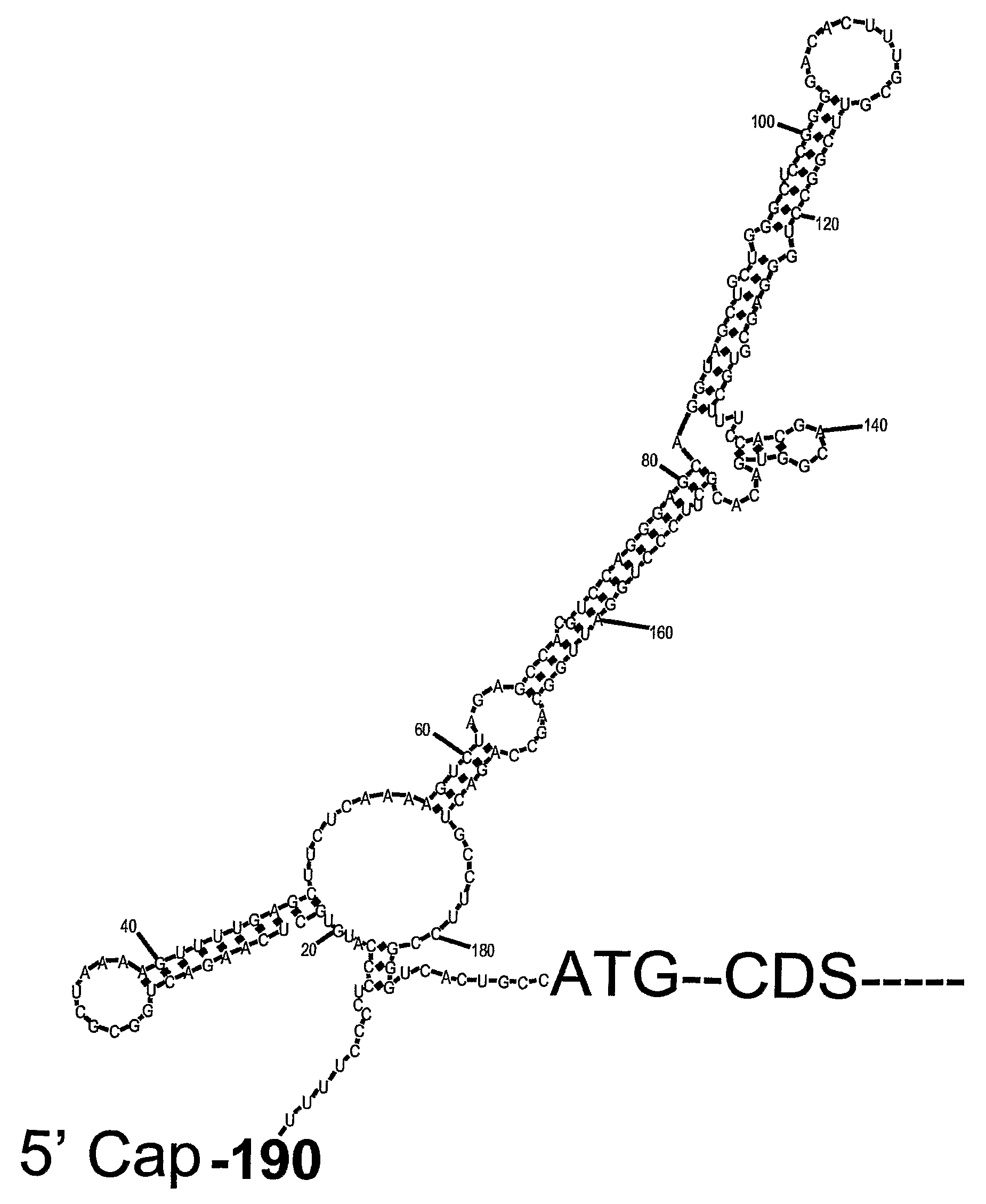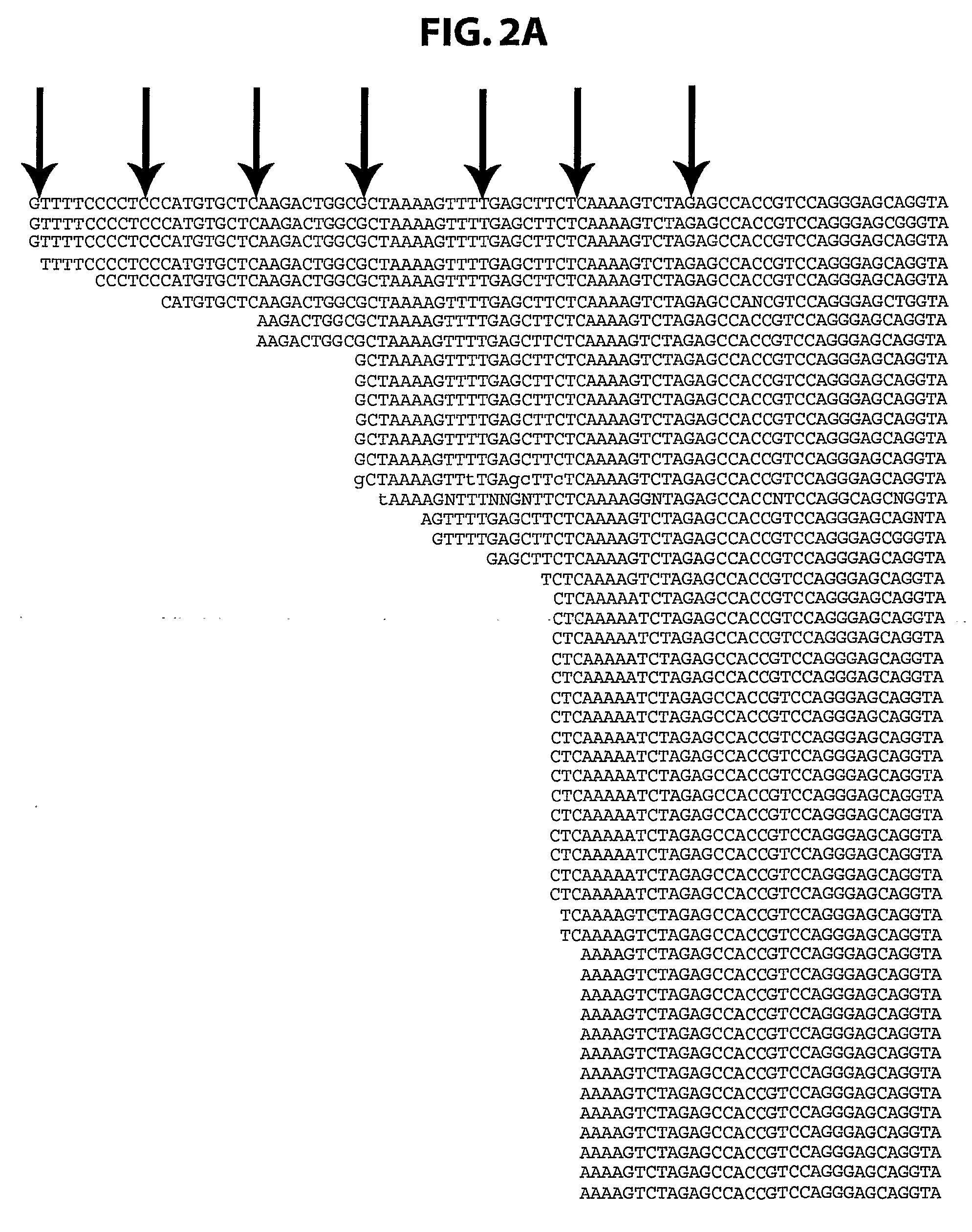[0028]Decreasing / blocking translation of a wild-type p53 tumor
suppressor protein can lead to enhanced survival of a
cell. Decreasing translation of p53 or blocking its induction is useful, for example, for protection from
cell killing which results from cellular stresses such as
ionizing radiation, presence of
a DNA damaging agent, hypoxia,
hyperthermia, oxidation damage, chemical carcinogens, chemotherapeutic agents, UV light, etc.
[0029]Also, as specified in the Background Section above, decreasing translation of p53 or blocking its induction can suppress neuronal mitochondrial membrane
depolarization and
cytotoxicity associated with neurodegenerative disorders such as Huntington's
Disease.
[0030]Accordingly, the methods of the invention can be used, for example, for (i) protection from toxicities of
chemotherapy and
radiation therapy (in particular, in the treatment of tumors containing
mutant p53 (about 50% of all human tumors), where the decreasing / blocking p53 translation could protect the
normal tissue but not affect the response of the tumor), or unplanned
radiation exposure (e.g., terrorist act), (ii) reducing tissue /
cell damage in hypoxia-
reperfusion injury (e.g., during blocked
blood supply,
stroke or
ischemia), or as a result of
oxidative stress (e.g., in certain neurodegenerative disorders), or as a result of stresses associated with injuries (e.g., bums), or in naturally occurring diseases (e.g.,
hyperthermia associated with fever) or in
hyperthermia, (iii) inhibiting / decreasing tissue /
cell aging, (iv) reducing or eliminating p53-dependent neuronal death or damage (e.g., after brain or
spinal cord injury or seizure), (v) preservation of tissues and organs prior to
transplanting, or (vi) protecting cells of the
central nervous system from
cytotoxicity associated with neurodegenerative disorders (e.g., Huntington's
Disease, Parkinson's
Disease,
ataxia-
telangiectasia,
amyotrophic lateral sclerosis (ALS) and the like).
[0031]The present invention therefore provides a method for preventing negative effects of a cellular stress in a
mammal, which method comprises decreasing the level of the p53 tumor suppressor protein in the cells of the
mammal, which cells have been subjected to stress, by decreasing the stress-induced p53 mRNA translation in said cells, wherein p53 mRNA translation is decreased by modulating a function of a p53 5′UTR. The present invention also provides a method for protecting cells of the
central nervous system from
cytotoxicity associated with neurodegenerative disorders in a
mammal, which method comprises decreasing the level of the p53 tumor suppressor protein in the cells of the
central nervous system of the mammal by decreasing the stress-induced p53 mRNA translation in said cells, wherein p53 mRNA translation is decreased by modulating a function of a p53 5′UTR. In one embodiment, the invention provides a method for preventing negative effects of a cellular stress or protecting cells of the central
nervous system from cytotoxicity associated with neurodegenerative disorders in a mammal, which method comprises decreasing the level of the p53 tumor suppressor protein in the cells of the mammal by decreasing the level or activity of RPL26 in said cells. In a specific embodiment, the level or activity of RPL26 is decreased using a short interfering
RNA (siRNA) molecule. In a further specific embodiment, the level or activity of RPL26 is decreased using an siRNA molecule having the sequence CCGAAAGGAUGAUGAAGUUUU (SEQ ID NO: 8). In another embodiment, the invention provides a method for preventing negative effects of a cellular stress or protecting cells of the central
nervous system from cytotoxicity associated with neurodegenerative disorders in a mammal, which method comprises decreasing the level of the p53 tumor suppressor protein in the cells of the mammal by increasing the level or activity of
nucleolin in said cells.
 Login to View More
Login to View More 


